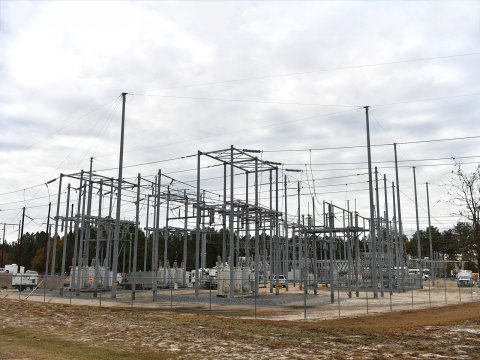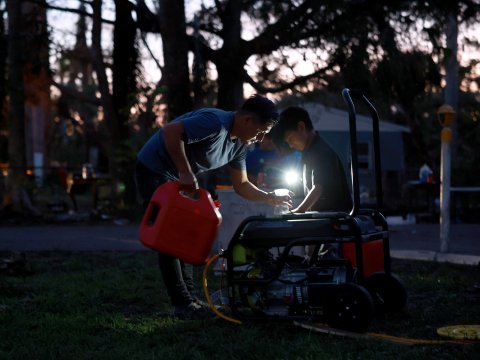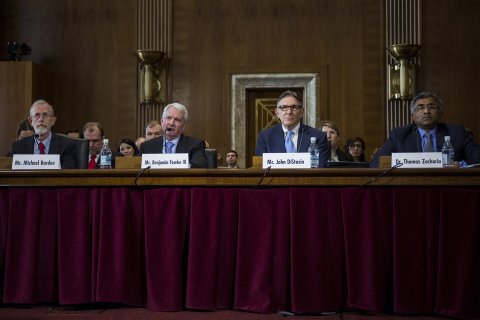Most people ignore the electrical grid, until it stops working. When that happens, the disruption can be total, but most often is a matter of inconvenience—the lights go out, the internet goes down, there is no place to recharge a cell phone.
But what if power did not return for days, weeks or months? And what if such a lengthy blackout engulfed not just a neighborhood or a county but a wide swath of the nation? The consequences, experts say, would be devastating. Many people would have no water to drink, no gas for their cars, no heat for their homes. They wouldn't be able to cash a paycheck, use a credit card or call an ambulance. Food, vital medicines and other essentials would grow scarce because trucks would be unable to refuel. Virtually every aspect of life would come to a halt. Casualties could run into the millions.

The possibility of widespread and prolonged outages may seem to many people like the stuff of science fiction, but security experts now believe that the chance of such a disaster is higher than it's ever been—and rising.
In the first eight months of 2022, the U.S. electrical grid was physically attacked 107 times, according to the U.S. General Accounting Office—the most in more than a decade. On December 3, shootings at two substations in Moore County, North Carolina, plunged more than 40,000 people into darkness. Reports have since emerged of other recent acts of sabotage, including a series of attacks against four sites in Pierce County, Washington, leaving around 14,000 people without power on Christmas Day.

These attacks, authorities believe, are coming from domestic extremists, who in recent months have shown a newfound willingness to strike at transformers and power lines. According to chatter on right-wing websites and social media platforms, they may also be planning coordinated attacks. A number of posts seen by Newsweek include specific instructions on how to inflict maximum damage to substations.
The U.S. electrical grid is highly vulnerable to domestic terrorism in a way that is reminiscent of airlines before the 9/11 attacks in 2001. The hundreds of thousands of miles of high-voltage power lines and tens of thousands of transmission substations that make up the power network are, practically speaking, impossible to police. And regulators and operators have not prepared adequately for the possibility of a concerted attack by domestic terrorists.
It is an open secret among security mavens that homegrown terrorists could easily pull off an operation that results in widespread outages and a significant loss of life. All it would take, they say, is a series of modestly coordinated, relatively low-tech strikes against a few key nodes of the network.
"If you have a physical attack that damages equipment, it can take weeks, months or years to replace that equipment," says Michael Mabee, a former U.S. Army command sergeant major and an expert in power infrastructure vulnerabilities. "If enough of these transformers were destroyed in a physical attack, we would have a long-term, wide-scale blackout, and the deaths would be in the tens of thousands, hundreds of thousands or millions."
The Moore County attack, in particular, has experts worried. It caused a serious disruption to service, the assailants have not been caught, and it seems to be part of a broad escalation. The possibility of more such attacks in a coordinated fashion, designed to cause irreparable damage to the grid, poses an "existential threat to the United States," says Mabee.
Threat From Radical Groups
No group has claimed responsibility for the December 3 attack in Moore County. Authorities are investigating a conservative group called the Moore County Citizens for Freedom, whose director, former U.S. Army psychological operations officer Emily Grace Rainey, is under investigation for leading a group to participate in the riots at the Capitol on January 6, 2021. Rainey was a vocal supporter of protests involving right-wing militias against a drag show being held at a local theater at the time of the North Carolina substation attacks, and the Moore County Sheriff's office visited her home after she claimed to "know why" the power was cut. No charges have been filed against her, her group or anyone else in connection with the attacks. On social media, Rainey attributed them to an act of "God," who was "chastising Moore County" over the LGBTQ-friendly event.
While many of the saboteurs behind past attacks are unknown — domestic groups generally don't claim responsibility — Newsweek has obtained documents that show how homegrown radicals share material and manifestos. A corporate intelligence security memo and an intelligence assessment issued in October by the California State Threat Assessment Center detailed dozens of examples of domestic radicals sharing plots and methods for carrying out attacks on U.S. infrastructure, as well as recent examples of violent attacks already carried out at sites across the country. Most are associated with "accelerationist," far-right and neo-Nazi ideologies that see the power grid as a weak point to bring down the nation.

In March, for instance, a shooting at a Red River Valley Rural Electric Association site in southern Oklahoma left thousands of people without power and resulted in a major oil leak. The transformer, a model that typically costs between $800,000 and $1 million, had to be replaced. In July, shots were fired at a transmission site in Wasco, California, resulting in a spill of hundreds of gallons of hazardous chemicals. Separately, a transformer serving the Keystone pipeline near Huron, South Dakota, was vandalized that same month, reducing the oil artery's rate of operations. The California State Threat Assessment Center identified these "noteworthy incidents" along with other attacks in the context of the domestic extremist threat, though the perpetrators and their motives remain unknown.
Although the recent attacks have been mostly small in scale, experts fear that security is so poor at many points in the nation's sprawling network of transmission lines, transformers and other critical nodes that terrorist groups could easily cause massive disruptions. And even limited sabotage, which neo-Nazis have celebrated on far-right channels on social media sites such as Telegram and 4Chan, can also serve to whip up enthusiasm for further attacks.
Indeed, calls for more frequent and larger strikes against major U.S. cities, with the aim of sowing chaos, have lately grown more strident, according to recent reports by SITE Intelligence Group and the Middle East Media Research Institute's (MEMRI) Domestic Terrorism Threat Monitor.
One white supremacist Telegram channel included calls for attacks against substations, railways and commercial sites such as grocery stores and Amazon distribution centers. A short video appeared to show two men shooting a "water plant" with rifles. The same channel celebrated the Moore County attacks as an act of "magnificent sabotage" and "beautiful escalation" in an anti-LGBTQ culture war. Others called for large-scale attacks on New York City, Washington, D.C. and other cities. A user on 4Chan, who self-identified as "the current Chancellor of the 4th Reich," called on like-minded individuals to attack substations in any area of the country that was "not majority white."
Because these communications are anonymous, it's difficult for the law enforcement to track down who is behind them. Still, security experts say the threats are credible, not least because they correspond to an increase in physical attacks.
"Our modern civilization depends on electricity," Tommy Waller, executive vice president for the Center for Security Policy, tells Newsweek. "Therefore, the electric grid is a prime target for a wide variety of bad actors, both foreign and domestic, ranging from the far right to the far left."
Nature of the Vulnerability
Law enforcement has successfully thwarted some extremist plots against the power grid. For instance, in February, three white supremacists were sentenced for planning a coordinated attack on three substations in different regions of the U.S. in a bid to start a race war. But most attacks remain unsolved.
One of the most notable in the last decade—and possibly an inspiration for extremists—was an assault on a substation in Metcalf, California, in April 2013. The perpetrators, still unknown to this day, opened fire with rifles on 17 transformers at a Pacific Gas and Electric Company site. This attack, like the one in Moore County, hints at the true vulnerabilities that extremists seeking a broader shutdown have begun to broadcast.

Both the Metcalf and Moore County attacks resulted in mostly superficial damage to transformers that was able be repaired quickly. Had the damage been more significant, however, the resulting outages would have been far more difficult to fix. Most electric power equipment, such as transformers and circuit breakers, is made abroad. Although some manufacturers are based in Mexico, Germany and Japan, by far the biggest supplier is China, which itself raises questions of national security. In any case, importing custom-made equipment is costly and time consuming—new orders take months to fill.
The vulnerability of the grid to sabotage has long been common knowledge. After the 2013 Metcalf attack, the Federal Energy Regulatory Commission (FERC) spelled out how damage to just nine key substations and one of the few domestic transformer manufacturers could cripple the entire U.S. power grid for at least 18 months.
Extremist groups have apparently absorbed this lesson. In far-right material propagated online, Newsweek has seen references to both the Metcalf attacks and what has come to be known as the "nine substation problem" identified by FERC.
"I was very, very concerned—extremely concerned—in 2013," says Jon Wellinghoff, head of FERC at the time. "And I would say, after Moore County, that I'm still extremely concerned."
Today, he warns that there still exists "some limited number of critical nodes within the U.S. grid that could have severe consequences" if significantly damaged. "The threat is real," he tells Newsweek. "Americans should be concerned."

Efforts to Build Resilience in the Grid
A straightforward way to avoid the worst consequences of an extremist attack is to invest in making the electrical grid more resilient. One reason a handful of attacks can cause widespread failure is that the grid is vulnerable to cascading blackouts, where a small disturbance has ripple effects far and wide.
That's exactly what happened in the Great Northeast Blackout of 2003, which affected 55 million people in the U.S. and Canada. The disaster was ultimately traced to a single cause: tree branches that came down on three transmission lines in northern Ohio. This relatively minor event, along with a series of human and software errors, caused grid failures through eight U.S. states and Ontario, including the major metropolitan areas of New York City and Toronto.
Following the disaster, Congress passed the Energy Policy Act in 2005, which set reliability standards for utility companies for most of the power system. But critics say the utility companies were given too much leeway. Rather than having federal regulators set the rules, Congress empowered the utilities to delegate that task to a nonprofit entity known as the North American Reliability Council (NERC), which is largely overseen by members of the utility industry itself.
"The regulations for physical security and in cybersecurity are not written by any federal regulators," says Wellinghoff. "They are instead written by the utilities themselves, and those regulators only can adopt or reject them."
Once approved by FERC, the utilities are also in charge of enforcing the rules. "It's a very difficult task to ensure that 3,000 utilities around the country are actually complying with regulations that the utility industry themselves wrote," says Wellinghoff. The effort to shore up the resiliency of the U.S. power grid, he says, was "less than aggressive."
A NERC spokesperson tells Newsweek, "keeping the lights on for the citizens of North America is a daunting task and is just too important to be done by anyone other than an expert charged in the field—anything less would be unacceptable."
Regarding the recent rise in security threats, the spokesperson points out that "physical security events have a wide range—from errant bullets from hunters, arson to copper thefts, which are the most common physical threat." A FERC spokesperson says, "the security and reliability of the nation's electric grid remain our top priorities."

Current regulations do not require utility companies to keep spare parts on hand, which could reduce the likelihood of long-term blackouts. However, says the NERC spokesperson, "our standards do require entities to be able to operate without overloading the system."
Many critics feel that lawmakers have not done enough to make the grid resilient to attacks. Two attacks in particular—the one in Metcalf in 2013 and the recent attack in Moore County—demonstrate that the reforms made after the Great Northeast Blackout of 2003 were inadequate, they say.
Securing the grid should be "a bi-partisan and common-sense national security issue," says Waller. "Unfortunately, efforts to do so have failed under both Republican and Democratic presidential administrations. No matter who is responsible for recent outages, Americans must demand better grid security."
Lack of Political Will
Just how to implement this security is a matter of debate. Some power companies have already been shoring up physical security beyond the limited scope of existing regulations, mostly in response to increasingly frequent natural disasters, says Avi Schnurr, CEO and president of the Electric Infrastructure Security (EIS) Council.
Some law enforcement experts doubt that any plan to physically guard sites could realistically be enforced across the nation. The grid is too large and spread out to be able to police effectively. "What do they want us to do, patrol power lines?" says a senior law enforcement official who worked on counterterrorism at the FBI-led Joint Terrorism Task Forces, who requested anonymity due to the sensitive nature of the field.
Utilities have made efforts to improve coordination during outages. Using a strategy of "mutual assistance," utilities tap into a nationwide network of technicians to restore power, usually in response to severe weather events that regularly batter large parts of the U.S., including Florida, Texas and Puerto Rico.
Utility companies are also availing themselves of new tools that would help them cope with widespread outages. In the event of so-called "blackstarts," in which a major portion of the grid fails and has to be restarted from scratch, utilities are putting in place secure communication systems, long-duration power cells that allow workers to operate in otherwise absolute darkness, and chaos management and decision support systems that use artificial intelligence to aid in diagnostics and decision making.
For the moment, the ability to use these new technologies under emergency conditions is untested. In a major disaster, where blackouts drag on for weeks, how much these tools will help remains to be seen.

"Generally speaking, such restart operations will require far more time than we have experienced with any grid restoration event seen previously in the continental U.S.," Schnurr says. "In such a disaster, grid restart and restoration would take weeks, at best. And if an attack has caused extensive damage to grid assets, restoration times could be far longer."
Despite these improvements in defenses and planning for worst-case scenarios, many experts are skeptical that the utilities are prepared to cope with a major attack. Compared to the magnitude of the threat, expenditures on physical security so far have been "modest," says Thomas Popik, chairman and president of the Foundation for Resilient Societies, who has given testimony to utility regulators and lawmakers. On interstate highways, he says, "we can see miles of concrete barriers for the sole purpose of sound protection against adjacent neighborhoods. If the same resources were put into concrete barriers around electric grid substations, we'd all be much more secure."
He worries, in particular, about what he views as a "deadly tendency" in the U.S., and other democracies, to take action only after disaster has struck. "If a major attack is required to get the attention of policymakers and regulators, America may not get a second chance," he says. "That's the reality.
"The first really big attack could be the last big attack, because that's it for America — light's out."












